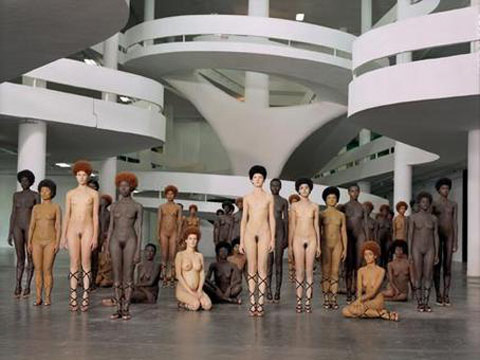Gillian Wearing is a British artist. Her first major work was “Signs that say what you want them to say and not Signs that say what someone else wants you to say” which was first displayed in 1992 at the City Racing in London. In this work she went up to people in public and asked them to write something on a piece of paper.
 Wearing then took a photo of these people holding the piece of paper they wrote on. These photos highlight people true inner thoughts. This kind of works makes you think about your own social assumptions and perceptions that you make about people and society as a whole. Another work that Wearing utilized the public was “Confess All On Video. Don't Worry You Will Be in Disguise. Intrigued? Call Gillian” that debuted in 1994. In this work she had people come in and confessed to things they would normally never tell anyone they had done.
Wearing then took a photo of these people holding the piece of paper they wrote on. These photos highlight people true inner thoughts. This kind of works makes you think about your own social assumptions and perceptions that you make about people and society as a whole. Another work that Wearing utilized the public was “Confess All On Video. Don't Worry You Will Be in Disguise. Intrigued? Call Gillian” that debuted in 1994. In this work she had people come in and confessed to things they would normally never tell anyone they had done.  The trick is each person was discussed in a mask, which allowed him or her to tell the truth or lie. This kind of piece highlights what kind of things we frown upon in society such as stories of inappropriate behavior and lying. Due to the masks people are allowed to openly do both I front of the public.
The trick is each person was discussed in a mask, which allowed him or her to tell the truth or lie. This kind of piece highlights what kind of things we frown upon in society such as stories of inappropriate behavior and lying. Due to the masks people are allowed to openly do both I front of the public.Another artist that works utilize the public to highlight different elements in society is Vanessa Beecroft. Vanessa Beecroft is an Italian artist. She puts on performances that feature models. These models are mostly women sometimes nude and she organizes them in different spaces and documents them through photography. These performances highlight certain aspects of society and different assumptions of society similar to Gillian Wearing’s work.  "VB 50"
"VB 50"
In one piece called “VB 50”, she organized a group of nude female models of different skin tones and hair colors. She intended to highlight the definition of beauty found in advertising and the multi-cultural nature of society. "VB 50"
"VB 50"Both of these artists highlight different aspects of society in their work. I find Gillian Wearing’s work more effective at highlighting assumptions and perceptions found in society. In her work with the photos of people holding signs one makes perceptions about the person before you read the sign. For instance, one photo shows a policeman holding a sign.
 Ordinarily we see policemen as figures of authority that seem to be in control of situations they find themselves in. But his sign says the word “help”. Which suggest that unlike his appearance his thoughts portray an idea of not being in control and of needing assistance from others. I find that Vanessa Beecroft’s work is much harder to interpret the message that the performance is trying to portray. In “VB 50” at a first glance one wouldn’t find the message of the performance but after you think about how this compares with other portrayals of women in society one can draw out the message that the artist intended. But both artists make good use of the public to highlight the themes that they want to portray about society.
Ordinarily we see policemen as figures of authority that seem to be in control of situations they find themselves in. But his sign says the word “help”. Which suggest that unlike his appearance his thoughts portray an idea of not being in control and of needing assistance from others. I find that Vanessa Beecroft’s work is much harder to interpret the message that the performance is trying to portray. In “VB 50” at a first glance one wouldn’t find the message of the performance but after you think about how this compares with other portrayals of women in society one can draw out the message that the artist intended. But both artists make good use of the public to highlight the themes that they want to portray about society.

